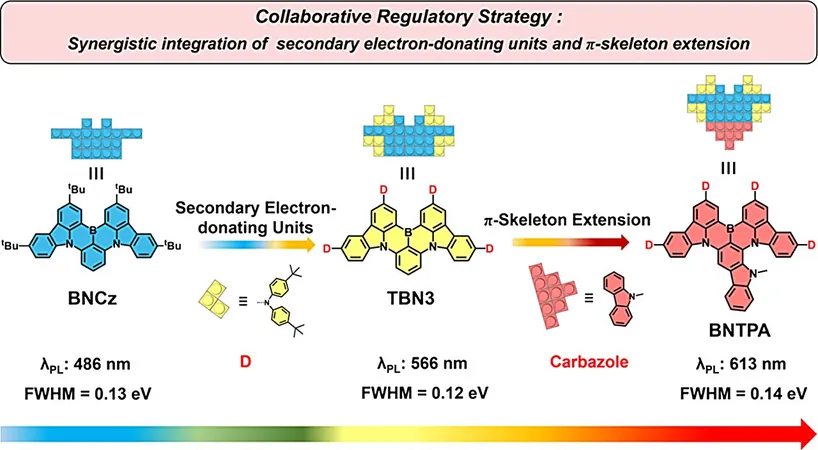
Breakthrough in Pure Red OLED Materials: A Game Changer for Ultra High-Definition Displays!
2024-12-09
Author: Amelia
Introduction
In an exciting development reported in the Journal of the American Chemical Society, a research team has unveiled a cutting-edge strategy for creating pure-red organic light-emitting diode (OLED) materials, achieving remarkable electroluminescence efficiencies that exceed 43%! This groundbreaking advancement could be crucial for the evolution of high-performance ultra high-definition OLED displays.
The Importance of OLED Technology
OLED technology is already a frontrunner in the display world, praised for its remarkable flexibility, vibrant colors, and self-emission capabilities. However, the efficiency and performance of red OLEDs, particularly in the saturated red spectrum, have historically trailed behind their blue and green cohorts. This inefficiency has posed a significant barrier to developing displays that meet today’s demanding color standards.
Innovative Design Techniques
To overcome this longstanding challenge, the research team has emphasized innovative design techniques that optimize red emitting materials for high luminous efficiency, pure color output, and long-term stability. Central to their strategy is the molecular design of BNTPA, an innovative compound engineered with secondary electron-donating units that enhance its π-skeleton within multiresonance cores.
Achieving High Performance
This structural tweak significantly boosts the charge transfer efficiency, allowing the molecule to manage excitation energy more effectively. The impressive result? A shift in light emission to a rich red spectrum, all while preserving narrowband characteristics essential for high color fidelity—an indispensable aspect for high-definition displays.
Enhancements in Charge Transfer
In addition, the team's optimization of the reverse inter-system crossing (RISC) process marks a substantial gain in performance. The refined structure of BNTPA accelerates the RISC rate and achieves a harmonious blend of short-range and long-range charge transfer, crucial for maximizing photophysical performance.
Minimizing Energy Loss
This exquisite balance minimizes energy loss while enhancing both luminous efficiency and operational stability. The incorporation of secondary electron-donating units further stabilizes the excited states of BNTPA, significantly reducing non-radiative decay and the resulting energy loss that is often a pitfall in red-emitting materials.
Future Applications and Implications
With these enhancements, BNTPA-based OLEDs promise greater durability and longer lifespans, positioning them for practical applications in modern technologies. Their exceptional performance has resulted in an external quantum efficiency of over 43%, with a CIE value of (0.657, 0.343)—aligning closely with the NTSC standards (0.67, 0.33) and ensuring superb color purity.
Conclusion
This pivotal research not only sets the stage for future discoveries in the realm of high-definition displays and next-generation electronic devices but also contributes significantly to the advancement of energy-efficient, resilient lighting systems. As the demand for sophisticated color standards in displays grows, this breakthrough could be the key to revolutionizing how we experience visual media.
Acknowledgements
The research efforts were spearheaded by Prof. Cui Songlin from the University of Science and Technology of China (USTC), in collaboration with Prof. Zhou Meng’s team at Beijing Information Science and Technology University (BISTU). Keep an eye on this innovative research as it paves the way for the future of display technology that could change how we interact with our world!
Stay Tuned!
Stay tuned for more incredible breakthroughs that might redefine the boundaries of technology!



 Brasil (PT)
Brasil (PT)
 Canada (EN)
Canada (EN)
 Chile (ES)
Chile (ES)
 Česko (CS)
Česko (CS)
 대한민국 (KO)
대한민국 (KO)
 España (ES)
España (ES)
 France (FR)
France (FR)
 Hong Kong (EN)
Hong Kong (EN)
 Italia (IT)
Italia (IT)
 日本 (JA)
日本 (JA)
 Magyarország (HU)
Magyarország (HU)
 Norge (NO)
Norge (NO)
 Polska (PL)
Polska (PL)
 Schweiz (DE)
Schweiz (DE)
 Singapore (EN)
Singapore (EN)
 Sverige (SV)
Sverige (SV)
 Suomi (FI)
Suomi (FI)
 Türkiye (TR)
Türkiye (TR)
 الإمارات العربية المتحدة (AR)
الإمارات العربية المتحدة (AR)